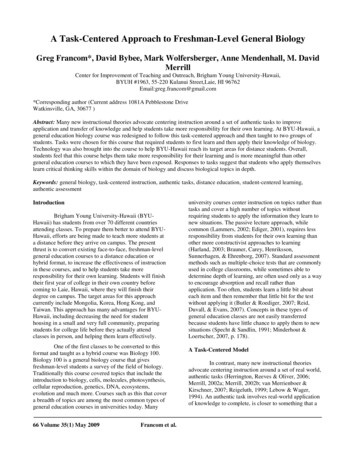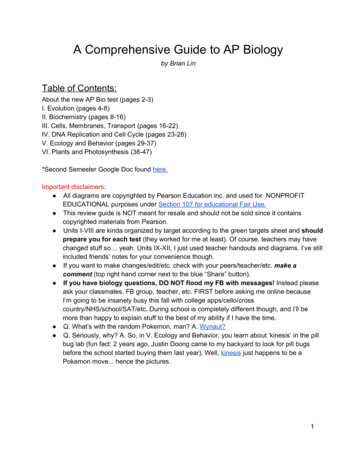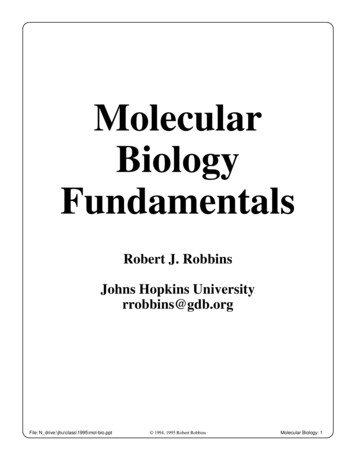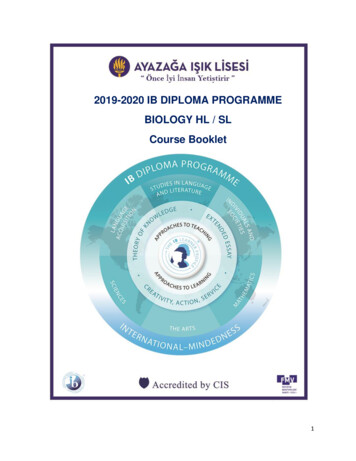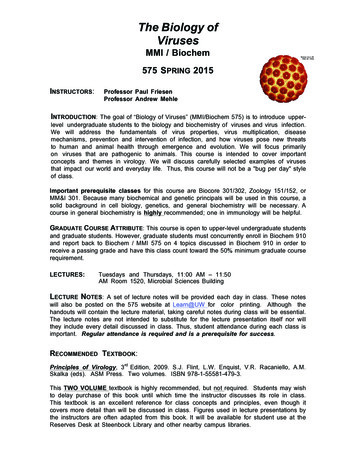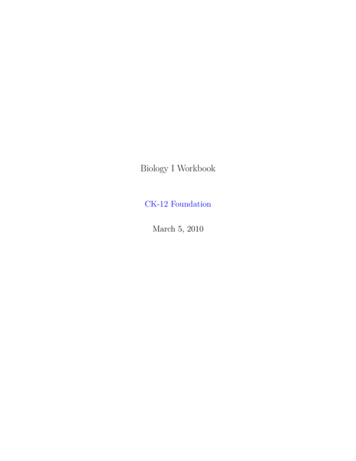
Transcription
Biology I WorkbookCK-12 FoundationMarch 5, 2010
CK-12 Foundation is a non-profit organization with a mission to reduce the cost of textbookmaterials for the K-12 market both in the U.S. and worldwide. Using an open-content, webbased collaborative model termed the “FlexBook,” CK-12 intends to pioneer the generationand distribution of high quality educational content that will serve both as core text as wellas provide an adaptive environment for learning.Copyright 2009 CK-12 FoundationThis work is licensed under the Creative Commons Attribution-Share Alike 3.0 United StatesLicense. To view a copy of this license, visit http://creativecommons.org/licenses/by-sa/3.0/us/ or send a letter to Creative Commons, 171 Second Street, Suite 300, SanFrancisco, California, 94105, USA.
Contents1 Foundations of Life Science Worksheets91.1Chapter 1: Foundations of Life Science . . . . . . . . . . . . . . . . . . . . .91.2Lesson 1.1: Nature of Science . . . . . . . . . . . . . . . . . . . . . . . . . .91.3Lesson 1.2: Communicating Ideas . . . . . . . . . . . . . . . . . . . . . . . .141.4Lesson 1.3: Tools and Techniques . . . . . . . . . . . . . . . . . . . . . . . .191.5Lesson 1.4: Principles of Biology . . . . . . . . . . . . . . . . . . . . . . . .242 Chemical Basis of Life Worksheets312.1Chapter 2: Chemical Basis of Life . . . . . . . . . . . . . . . . . . . . . . . .312.2Lesson 2.1: Matter . . . . . . . . . . . . . . . . . . . . . . . . . . . . . . . .312.3Lesson 2.2: Organic Compounds . . . . . . . . . . . . . . . . . . . . . . . . .352.4Lesson 2.3: Chemical Reactions . . . . . . . . . . . . . . . . . . . . . . . . .402.5Lesson 2.4: Water . . . . . . . . . . . . . . . . . . . . . . . . . . . . . . . . .453 Cell Structure and Function Worksheets513.1Chapter 3: Cell Structure and Function . . . . . . . . . . . . . . . . . . . . .513.2Lesson 3.1: Introduction to Cells . . . . . . . . . . . . . . . . . . . . . . . .513.3Lesson 3.2: Cell Structures . . . . . . . . . . . . . . . . . . . . . . . . . . . .573.4Lesson 3.3: Cell Transport and Homeostasis . . . . . . . . . . . . . . . . . .624 Photosynthesis Worksheets4.167Chapter 4: Photosynthesis . . . . . . . . . . . . . . . . . . . . . . . . . . . .367www.ck12.org
4.2Lesson 4.1: Energy for Life: An Overview of Photosynthesis . . . . . . . . .674.3Lesson 4.2: Into the Chloroplast: How Photosynthesis Works . . . . . . . . .725 Cellular Respiration Worksheets795.1Chapter 5: Cellular Respiration . . . . . . . . . . . . . . . . . . . . . . . . .795.2Lesson 5.1 Powering the Cell: Cellular Respiration and Glycolysis . . . . . .795.3Lesson 5.2: Into the Mitochondrion: Making ATP with Oxygen . . . . . . .855.4Lesson 5.3: Anaerobic Respiration: ATP, New Fuels, and Yogurt withoutOxygen . . . . . . . . . . . . . . . . . . . . . . . . . . . . . . . . . . . . . .906 Cell Division and Reproduction Worksheets956.1Chapter 6: Cell Division and Reproduction . . . . . . . . . . . . . . . . . . .956.2Lesson 6.1: Chromosomes and the Cell Cycle956.3Lesson 6.2: Meiosis . . . . . . . . . . . . . . . . . . . . . . . . . . . . . . . . 1007 Mendelian Genetics Worksheets. . . . . . . . . . . . . . . . .1077.1Chapter 7: Mendelian Genetics . . . . . . . . . . . . . . . . . . . . . . . . . 1077.2Lesson 7.1: Mendel’s Investigations . . . . . . . . . . . . . . . . . . . . . . . 1077.3Lesson 7.2: Mendelian Inheritance . . . . . . . . . . . . . . . . . . . . . . . . 1128 Molecular Genetics Worksheets1198.1Chapter 8: Molecular Genetics. . . . . . . . . . . . . . . . . . . . . . . . . 1198.2Lesson 8.1: DNA and RNA . . . . . . . . . . . . . . . . . . . . . . . . . . . 1198.3Lesson 8.2: Protein Synthesis . . . . . . . . . . . . . . . . . . . . . . . . . . 1248.4Lesson 8.3: Mutation . . . . . . . . . . . . . . . . . . . . . . . . . . . . . . . 1298.5Lesson 8.4: Regulation of Gene Expression . . . . . . . . . . . . . . . . . . . 1349 Mendelian Genetics Worksheets1419.1Chapter 9: Human Genetics . . . . . . . . . . . . . . . . . . . . . . . . . . . 1419.2Lesson 9.1: Human Genes and Chromosomes . . . . . . . . . . . . . . . . . . 1419.3Lesson 9.2: Human Inheritance . . . . . . . . . . . . . . . . . . . . . . . . . 146www.ck12.org4
10 Biotechnology Worksheets15110.1 Chapter 10: Biotechnology . . . . . . . . . . . . . . . . . . . . . . . . . . . . 15110.2 Lesson 10.1: DNA Technology . . . . . . . . . . . . . . . . . . . . . . . . . . 15110.3 Lesson 10.2: Biotechnology. . . . . . . . . . . . . . . . . . . . . . . . . . . 15811 History of Life Worksheets16311.1 Chapter 11: History of Life . . . . . . . . . . . . . . . . . . . . . . . . . . . 16311.2 Lesson 11.1: Studying the History of Life . . . . . . . . . . . . . . . . . . . . 16311.3 Lesson 11.2: Early Life . . . . . . . . . . . . . . . . . . . . . . . . . . . . . . 16811.4 Lesson 11.3: Multicellular Life . . . . . . . . . . . . . . . . . . . . . . . . . . 17312 Evolutionary Theory Worksheets17913 Evolutionary Theory Worksheets18112.1 Lesson 12.1: Darwin and The Theory of Evolution . . . . . . . . . . . . . . . 18112.2 Lesson 12.2: Evidence for Evolution . . . . . . . . . . . . . . . . . . . . . . . 18612.3 Lesson 12.3: Evolution Continues Today - Can We Control It? . . . . . . . . 19113 Evolution in Populations Worksheets19713.1 Lesson 13.1: Genetics of Populations . . . . . . . . . . . . . . . . . . . . . . 19713.2 Lesson 13.2: Genetic Change in Populations . . . . . . . . . . . . . . . . . . 20113.3 Lesson 13.3: The Origin of Species . . . . . . . . . . . . . . . . . . . . . . . 20414 Classification Worksheets21114.1 Lesson 14.1: Form and Function . . . . . . . . . . . . . . . . . . . . . . . . . 21114.2 Lesson 14.2: Phylogenetic Classification . . . . . . . . . . . . . . . . . . . . 21514.3 Lesson 14.3: Modern Classification Systems . . . . . . . . . . . . . . . . . . 21915 Principles of Ecology Worksheets22515.1 Lesson 15.1 Worksheets . . . . . . . . . . . . . . . . . . . . . . . . . . . . . 22515.2 Lesson 15.2 Worksheets . . . . . . . . . . . . . . . . . . . . . . . . . . . . . 2295www.ck12.org
15.3 Lesson 15.3 Worksheets . . . . . . . . . . . . . . . . . . . . . . . . . . . . . 23416 Biomes, Ecosystems, and Communities Worksheets23917 Biomes, Ecosystems, and Communities Worksheets24116.1 Lesson 16.1: Biomes . . . . . . . . . . . . . . . . . . . . . . . . . . . . . . . 24116.2 Lesson 16.2: Terrestrial Biomes . . . . . . . . . . . . . . . . . . . . . . . . . 24516.3 Lesson 16.3: Aquatic Biomes . . . . . . . . . . . . . . . . . . . . . . . . . . . 24916.4 Lesson 16.4: Community Interactions . . . . . . . . . . . . . . . . . . . . . . 25317 Populations Worksheets25917.1 Chapter 17: Populations . . . . . . . . . . . . . . . . . . . . . . . . . . . . . 25917.2 Lesson 17.1: Characteristics of Populations . . . . . . . . . . . . . . . . . . . 25917.3 Lesson 17.2: Population Dynamics . . . . . . . . . . . . . . . . . . . . . . . 26417.4 Lesson 17.3: Human Population Growth: Doomsday, Cornucopia, or Somewhere in Between? . . . . . . . . . . . . . . . . . . . . . . . . . . . . . . . . 26918 Ecology and Human Actions Worksheets27518.1 Chapter 18: Ecology and Human Actions . . . . . . . . . . . . . . . . . . . . 27518.2 Lesson 18.1: The Biodiversity Crisis. . . . . . . . . . . . . . . . . . . . . . 27518.3 Lesson 18.2: Natural Resources . . . . . . . . . . . . . . . . . . . . . . . . . 28018.4 Lesson 18.3: Natural Resources II: The Atmosphere . . . . . . . . . . . . . . 28518.5 Lesson 18.4: Climate Change . . . . . . . . . . . . . . . . . . . . . . . . . . 29019 The Human Body Worksheets29519.1 The Human Body . . . . . . . . . . . . . . . . . . . . . . . . . . . . . . . . . 29519.2 Lesson 1: Organization of the Human Body . . . . . . . . . . . . . . . . . . 29519.3 Lesson 1: Homeostasis and Regulation . . . . . . . . . . . . . . . . . . . . . 30120 Nervous and Endocrine Worksheets30720.1 Lesson 1: Nervous System . . . . . . . . . . . . . . . . . . . . . . . . . . . . 30720.2 Lesson 2: Endocrine System . . . . . . . . . . . . . . . . . . . . . . . . . . . 313www.ck12.org6
21 Circulatory and Respiratory Systems Worksheets31922 Immune System and Disease Worksheets32122.1 Chapter 40: Immune System and Disease . . . . . . . . . . . . . . . . . . . . 32122.2 Lesson 40.1: Nonspecific Defenses . . . . . . . . . . . . . . . . . . . . . . . . 32122.3 Lesson 40.2: Immune Response . . . . . . . . . . . . . . . . . . . . . . . . . 32722.4 Lesson 40.3: Immune System Diseases . . . . . . . . . . . . . . . . . . . . . 33222.5 Lesson 40.4: Environmental Problems and Human Health7. . . . . . . . . . 338www.ck12.org
www.ck12.org8
Chapter 1Foundations of Life Science Worksheets1.1 1.2Chapter 1: Foundations of Life ure of ScienceCommunicating IdeasTools and TechniquesPrinciples of BiologyLesson 1.1: Nature of ScienceLesson 1.1: True or FalseName ClassDateWrite true if the statement is true or false if the statement is false.1. Science involves objective, logical, and repeatable attempts to understand theprinciples and forces working in the natural universe.2. Scientific methods are based on gathering observable, empirical and measurableevidence that is critically evaluated.3. Scientific theories are supported by a great deal of data and evidence; theyhave yet to be proved false.4. In natural experiments, it is difficult to control all variables.5. The goal of science is to understand how everything works.9www.ck12.org
6. A superseded scientific theory is no longer considered the most complete description of reality by mainstream science.7. Scientists accept all claims, regardless of scientific evidence.8. A hypothesis is not really an educated guess, but is also based on what ascientist thinks could happen.9. Scientific laws are principles which can be used to predict the behavior of thenatural world.10. An observation can only be made in a controlled, experimental environment.11. Science can be used to answer all questions.12. Answering scientific questions usually begins with an observation.13. A law of nature is a scientific generalization based on a sufficiently largeamouont of data or evidence.14. Once an idea is accepted as scientific fact, that idea can never be changed.15. The Cell Theory, the Theory of Evolution and the Germ Theory of Diseaseare important theories of biology.Lesson 1.1: Critical ReadingName ClassDateRead this passage from the text and answer the questions that follow.ExperimentsA scientific experiment must have the following features: a control, so variables that could affect the outcome are reducedthe variable being tested reflects the phenomenon being studiedthe variable can be measured accurately, to avoid experimental errorthe experiment must be reproducible.An experiment is a test that is used to eliminate one or more of the possible hypothesesuntil one hypothesis remains. The experiment is a cornerstone in the scientific approach togaining deeper knowledge about the physical world. Scientists use the principles of theirhypothesis to make predictions, and then test them to see if their predictions are confirmedor rejected.Scientific experiments involve controls, or subjects that are not tested during the investigation. In this way, a scientist limits the factors, or variables that can cause the results of anwww.ck12.org10
investigation to differ. A variable is a factor that can change over the course of an experiment. Independent variables are factors whose values are controlled by the experimenterto determine its relationship to an observed phenomenon (the dependent variable). Dependent variables change in response to the independent variable. Controlled variables arealso important to identify in experiments. They are the variables that are kept constantto prevent them from influencing the effect of the independent variable on the dependentvariable.For example, if you were to measure the effect that different amounts of fertilizer have onplant growth, the independent variable would be the amount of fertilizer used (the changingfactor of the experiment). The dependent variables would be the growth in height and/ormass of the plant (the factors that are influenced in the experiment). The controlled variablesinclude the type of plant, the type of fertilizer, the amount of sunlight the plant gets, the sizeof the pots you use. The controlled variables are controlled by you, otherwise they wouldinfluence the dependent variable.In summary: The independent variable answers the question ”What do I change?” The dependent variables answer the question ”What do I observe?” The controlled variables answer the question ”What do I keep the same?”Questions 1. What is an experiment and how does an experiment relate to a hypothesis?2. What is the difference between a control and a variable in a scientific experiment?3. Discuss the differences between dependent variables and independent variables.4. What is a controlled variable? Provide an example.11www.ck12.org
5. If you were to conduct an experiment measuring the effect that different amounts offertilizer have on plant growth, what would be the independent variable(s), the dependentvariable(s), and the controlled variable(s).-Lesson 1.1: Multiple ChoiceName ClassDateCircle the letter of the correct choice.1. A scientific experiment must have the following features:A. a control, so variables that may affect the outcome are reduced.B. the variable being tested reflects the question being asked.C. the variable being tested can be measured accurately.D. all of the above2. In the general process of a scientific investigation, what comes directly after an observation?A. experimentB. predictionC. hypothesisD. theory3. A hypothesisA. is a suggested explanation for a phenomena based on evidence that can be tested byobservation or experimentation.B. is a guess.C. is based on what a scientist thinks could happen.www.ck12.org12
D. is an explanation of a scientific concept.4. A scientific theoryA. describes a guess or an opinion.B. is supported by a great deal of data and evidence.C. is the process of scientific investigation.D. is just another name for a hypothesis.5. Which of the following is not an accepted, verified scientific theory?A. Atomic TheoryB. String TheoryC. Theory of RelativityD. Theory of Evolution6. Which of the following are not true of a scientific law?A. Is a principle which can be used to predict the behavior of the natural world.B. Is well-supported by observations and/or experimental evidence.C. Is the same as a scientific theory.D. Usually refers to rules for how nature will behave under certain conditions.7. Arrows that are grouped tightly together but away from the bulls eye would be consideredA. accurate but not precise.B. precise but not accurate.C. neither accurate nor precise.D. both accurate and precise.Lesson 1.1: VocabularyName ClassDateMatch the vocabulary word with the proper defination.Term1. deduction2. variable13www.ck12.org
3. observation4. Occam’s razor5. control6. phenomenon7. skepticism8. dependent variable9. induction10. hypothesisDefinitiona. the act of noting or detecting a phenomenon through the sensesb. is any occurrence that is observablec. involves determining a single fact from a general statementd. states that the explanation for a phenomenon should make as few assumptions as possiblee. claims must be exposed to scientific testing through critical thinking before being acceptedf. a factor that can change over the course of an experimentg. changes in response to the independent variableh. a suggested explanation based on evidence that can be tested by observation or experimentationi. something that is not tested during the investigationj. involves determining a general statement that is very likely to be true, from several facts1.3Lesson 1.2: Communicating IdeasLesson 1.2: True or FalseName Class DateWrite true if the statement is true or false if the statement is false.1. Peer-reviewed journal articles have the lowest level of trust.2. One well known and well respected medical journal is JAMA.3. Systematic bias is introduced from a flaw in measurements.www.ck12.org14
4. A science magazine is written for an expert audience.5. Conducting science requires only human creativity.6. One source of research funding is from the military.7. Bioethics is a slow-growing academic area of inquiry.8. One application of biotechnology is bioremediation.9. The thale cress has been genetically modified to turn red, only in the presenceof nitrogen dioxide.10. “Snow World” is a virtual reality game.Lesson 1.2: Critical ReadingName Class DateRead this passage from the lesson and answer the questions that follow.Science in the MediaA lot of popular science articles come from sources whose aim is to provide a certain amountof entertainment to the reader or viewer. Many popular science articles will examine howa phenomenon relates to people and to their environment. Nevertheless, there is a tendency in the popular media to dilute scientific debates into two sides, rather than cover thecomplexities and nuances of an issue.Even well-intentioned scientists can sometimes unintentionally create truth-distorting mediafirestorms because of journalists’ difficulty in remaining critical and balanced, the media’sinterest in controversy, and the general tendency of science reporting to focus on apparent”groundbreaking findings” rather than on the larger context of a research field. Sometimesscientists will seek to exploit the power of the media. When scientific results are releasedwith great fanfare and limited peer review, the media often requires skepticism and furtherinvestigation by skilled journalists and the general public.The dichloroacetic acid (DCA) story, discussed earlier in this lesson, is an example of whatcan go wrong when a scientific discovery grasps the public’s attention.An intense amount of public interest was raised by the study and the story received muchmedia attention. As a result, the American Cancer Society and other medical organizationsreceived a large volume of public interest and questions about the “miracle cure,” DCA.One of the first stories about the findings contained the headline:“Cheap, ’safe’ drug kills most cancers”The article did explain that the studies were only carried out on cancer cells grown in the lab15www.ck12.org
and in rats. However, the headline may have given some readers the impression that humantesting of DCA was complete. People were wildly interested in this new “cure” to cancer.This prompted the American Cancer Society and other organizations to issue reports thatreminded people that although the study results were promising, no formal clinical trialsin humans with cancer had yet been carried out. They stressed the need for caution ininterpreting the early results. Doctors warned of possible problems if people attemptedto try DCA outside a controlled clinical trial. The media received some criticism for thesensation that arose due to their coverage of the discovery.Questions1. Rather than focusing on apparent “groundbreaking findings,” what should science reporting focus on?2. What do scientific results need prior to release to the public, in order to be the mostaccurate?3. If scientific results are not accurate when they are released to the public, what should bethe response of the media and the general public?4. In reporting about DCA, one of the first stories about the findings contained the headline:“Cheap, ‘safe’ drug kills most cancers.” The headline may have given some readers whatimpression?5. In response to the article mentioned in question 4, what was the response of the AmericanCancer Society?www.ck12.org16
Lesson 1.2: Multiple ChoiceName Class DateCircle the letter of the correct choice.1. In which of the following formats are scientific debates properly carried out and reviewed?A. scientific articles published in scientific journalsB. government reportsC. presentations at academic conferencesD. all of the above2. Which of the following is a well known and well respected science or medical journal?A. The Wall Street JournalB. The LancetC. Time MagazineD. none of the above3. The first section of a science article is called theA. materials and methods.B. introduction.C. abstract.D. discussion.4. Under what conditions might scientific misconduct occur?A. to keep up one’s reputationB. for commercial motivationC. for political motivationD. all of the above5. Which of the following is written for a non-expert audience?A. New ScientistB. Scientific AmericanC. International Polar Year websiteD. all of the above17www.ck12.org
6. When did Watson, Crick, and Franklin build a model of the double helix structure ofDNA?A. 1930sB. 1940sC. 1950sD. 1960s7. Which of the following is a source of funding for scientific research from a non-profitorganization?A. American Cancer SocietyB. Center for Disease ControlC. Food and Drug AdministrationD. none of the aboveLesson 1.2: VocabularyName Class DateMatch the vocabulary term with the correct definition.Term1. euthanasia2. conflict of interest3. reproducibility4. bioremediation5. peer review6. research scientist7. abstract8. scientific article9. ethics10. bioinformaticsDefinitiona. ability to repeat experiments and get the same resultsb. process of opening a scientist’s research or ideas to examination by other scientists whoare experts in the same fieldwww.ck12.org18
c. brief, usually one-paragraph, summary of the workd. choice by a terminally ill person to have medical assistance in dyinge. a written discussion of new research and findings, usually published in a scientific journalf. person that does scientific investigations and makes discoveriesg. situation in which a researcher has professional or personal interests that are at odds witheach otherh. an interdisciplinary field which helps solve biological problems using computersi. discipline concerned with what is morally good and bad, right and wrongj. use of microorganisms to clean up contaminated sites1.4Lesson 1.3: Tools and TechniquesLesson 1.3: True or FalseName Class DateWrite true if the statement is true or false if the statement is false.1. The SI system of measurement is based on multiples of 20.2. The symbol for meter is m.3. Kilo- is a multiple of a thousandth.4. A physics lab might contain a particle accelerator.5. Optical microscopes are the simplest and most widely used type of microscope.6. TEM images show the outside of an object.7. Scientific models are representations of reality.8. Latex gloves are recommended for lab use.9. Wear loose, floppy clothes in the lab.10. Common safety equipment in a school lab includes an eye-wash fountain.Lesson 1.3: Critical ReadingName Class DateRead this passage from the lesson and answer the questions that follow.19www.ck12.org
Scientific ModelsScientific models are representations of reality. To describe particular parts of a phenomenon,or the interactions among a set of phenomena, it is sometimes helpful to develop a model ofthe phenomenon. For instance, a scale model of a house or of a solar system is clearly notan actual house or an actual solar system; the parts of an actual house or an actual solarsystem represented by a scale model are, only in limited ways, representative of the actualobjects.Figure A model of planets of the solar system. This model is clearly not a real solar system;it is a representation of the planets Jupiter, Saturn, Neptune, and Uranus. Scientists userepresentations of natural things to learn more about them. Also, the visitors to the GriffithObservatory in Los Angeles can get a better idea of the relative sizes of the planets (andPluto!) by observing this model.Scientific modeling is the process of making abstract models of natural phenomena. Anabstract model is a theoretical construct that represents something. Models are developedto allow reasoning within a simplified framework that is similar to the phenomena beinginvestigated. The simplified model may assume certain things that are known to be incomplete in some details. Such assumptions can be useful in that they simplify the model, whileat the same time, allowing the development of acceptably accurate solutions. These modelsplay an important role in developing scientific theories.A simulation is a model that runs over time. A simulation brings a model to life andshows how a particular object or phenomenon will behave. It is useful for testing, analysisor training where real-world systems or concepts can be represented by a model. For thescientist, a model also provides a way for calculations to be expanded to explore whatmight happen in different situations. This method often takes the form of models thatcan be programmed into computers. The scientist controls the basic assumptions aboutthe variables in the model, and the computer runs the simulation, eventually coming to awww.ck12.org20
complicated answer.Examples of models include: Computer modelsWeather forecast modelsMolecular modelsClimate modelsEcosystem modelsGeologic modelsOne of the main aims of scientific modeling is to allow researchers to quantify their observations about the world. In this way, researchers hope to see new things that may haveescaped the notice of other researchers. There are many techniques that model builders usewhich allow us to discover things about a phenomenon that may not be obvious to everyone.Evaluating ModelsA person who builds a model must be able to recognize whether a model reflects reality. Theymust also be able to identify and work with differences between actual data and theory.A model is evaluated mostly by how it reflects past observations of the phenomenon. Anymodel that is not consistent with reproducible observations must be modified or rejected.However, a fit to observed data alone is not enough for a model to be accepted as valid.Other factors important in evaluating a model include: Its ability to explain past observationsIts ability to predict future observationsIts ability to control eventsThe cost of its use, especially when used with other modelsEase of use and how it looksQuestions1. What does a scientific model do?2. What is the advantage of assumptions in a model?-21www.ck12.org
3. What is a simulation?4. Name three examples of models.5. What is a model evaluated mostly by?-Lesson 1.3: Multiple ChoiceName Class DateCircle the letter of the correct choice.1. The SI system of measurement is based on multiples ofA. 10s.B. 20s.C. 50s.D. 100s.2. The following are SI base unitsA. meter.B. kilogram.C. kelvin.D. all of the above3. Equipment most likely found in a physics lab would includeA. Bunsen burners.B. a particle accelerator.www.ck12.org22
C. microscopes.D. none of the above4. Typical magnification of a light microscope is up toA. 500x.B. 1000x.C. 1500x.D. 2000x.5. An ocular lens with a magnification of 10x and an objective lens with a magnification of50x together will magnify an object byA. 60x.B. 100x.C. 250x.D. 500x.6. Biosphere 2 was built toA. forecast wind speeds and directions.B. attempt to recreate a self-sustaining biome.C. predict water flow in the Everglades.D. none of the above7. What are the best kind of shoes to wear in the lab?A. enclosed toe shoesB. sandalsC. flip flopsD. none of the aboveLesson 1.3: VocabularyName Class DateMatch the vocabulary term with the correct definition.Term1. microscopes23www.ck12.org
2. aseptic technique3. statistics4. stereo microscope5. lab techniques6. International System of Units (SI)7. simulation8. scientific modeling9. optical microscopeDefinitiona. the procedures used in science to carry out an experimentb. the measurements that scientists use; a form of the metric systemc. a mathematical science in which the collection, analysis, interpretation or explanation,and presentation of data is carried outd. a microscope that uses visible light and lenses to magnify objectse. a model that runs over timef. a light microscope with two ocular lensesg. instruments used to view objects that are too small to be seen by the naked eyeh. the process of making abstract models of natural phenomenai. laboratory procedures that are carried out under sterile conditions1.5Lesson 1.4: Principles of BiologyLesson 1.4: True or FalseName Class DateWrite true if the statement is true or false if the statement is false.1. One of the traits of a living organism is it grows and changes.2. The cell is the basic unit of life.3. Evolutionary theory cannot explain how specialized features develop in different species.www.ck12.org24
4. In mutualism, both organisms in the relationship are harmed.5. The biosphere includes all living things within all of their environments.6. About 80 percent of freshwater fish from South America are not yet classified.7. The Earth is about 2.0 billion years old.8. Oswald Avery and his colleagues identified DNA as the genetic material.9. Since 1953, genetics and molecular biology have become core aspects of evolutionary biology.10. Humans evolved from chimpanzees.Lesson 1.4: Critical ReadingName Class DateRead this passage from the lesson and answer the questions that follow.Unifying Principles of BiologyThere are four unifying principles of biology that are important for types of biology studies.These are:The Cell TheoryThe cell is the basic unit of life. The Cell Theory states that all living things are made ofone or more cells, or the secretions of those cells, such as the organisms shown in Figure 3.For example, shell and bone are built by cells from su
15.3Lesson15.3Worksheets . 234 16 Biomes, Ecosystems, and Communities Worksheets




